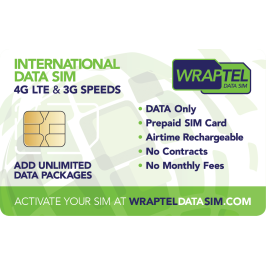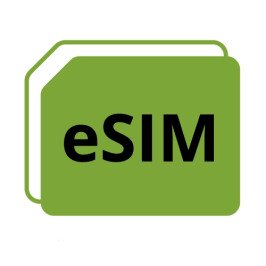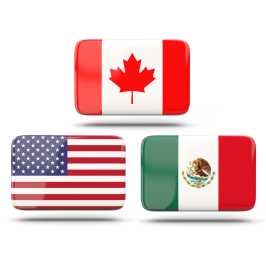eSIM vs. Local SIM: Which is the Best Data Option for Travelers?
Published: 20/01/2025
Constant connectivity is essential for anyone traveling abroad. Directions, booking confirmations, translation tools, and emergency communication are all powered by a solid data connection. Yet, deciding how to stay connected can be a challenge in unfamiliar territory. Should you buy a local SIM card in each country, or should you opt for a more flexible solution like an eSIM?
This article compares the primary methods travelers use to get online. At Wraptel, we have helped countless globetrotters avoid roaming nightmares and the hassle of swapping physical SIMs. Our goal is to illustrate the differences between eSIMs and local SIM cards so you can make an informed decision that matches your travel style.
While local SIMs once reigned supreme for affordability, eSIMs have emerged as a compelling alternative. Based on our experience, we believe the eSIM approach revolutionizes the way travelers connect, offering both freedom and reliability.
Key Takeaways
- eSIMs Offer Seamless Connectivity – eSIMs allow travelers to activate data plans instantly without swapping physical SIMs, making them a hassle-free option for multi-country trips.
- Local SIMs Can Be Cost-Effective for Single-Country Stays – If you``re staying in one destination for an extended period, a local SIM may provide cheaper in-country rates, though it requires manual setup and frequent top-ups.
- Device Compatibility Matters – Not all smartphones support eSIM technology, so travelers should check their device’s compatibility before opting for an eSIM solution.
- eSIMs Provide Multi-Country Coverage – Unlike local SIMs, which become obsolete when crossing borders, eSIMs offer flexible data plans that work across multiple countries under a single package.
- Wraptel Simplifies Global Connectivity – With extensive coverage in over 150 destinations, Wraptel’s eSIM plans provide a convenient, cost-effective alternative to traditional SIM cards, ensuring travelers stay connected effortlessly.
Tired of juggling SIM cards every time you cross a border? With an eSIM, you can stay connected seamlessly across multiple countries—no swapping required! Would you make the switch?
Understanding eSIM Technology
What Is an eSIM?
An eSIM, or embedded SIM, is a small chip permanently integrated into modern smartphones, tablets, and some wearables. Unlike physical SIM cards, which require manual swapping, an eSIM is activated digitally. Users scan a QR code or download a carrier profile through an app or website. This technology eliminates the need to handle tiny plastic cards while traveling.
The concept behind eSIM technology is straightforward: one device, multiple possibilities. Your phone can house various eSIM profiles from different carriers, allowing you to switch services at will. This is particularly useful when crossing borders or hunting for a better data deal. With each trip, you can simply load a new plan rather than buying another physical SIM.
Advantages of eSIM
- No Physical Swapping: There is no small card to remove or lose, making transitions between data plans nearly seamless.
- Multiple Profiles: Store more than one eSIM plan on your phone (though usually only one is active at a time), making it easy to toggle between personal and travel data plans.
- Space-Saving: Original SIM trays take space and can be a point of hardware failure. Embedded SIMs are built into the device, creating a more streamlined design.
- Instant Activation: Many eSIM providers, including Wraptel, enable activation within minutes. Land in a new country, scan a QR code, and you are online.
Limitations of eSIM
- Device Compatibility: Older phones and some budget models might not support eSIM technology. It is crucial to verify compatibility before traveling.
- Carrier Support: While eSIM adoption has grown, a handful of carriers have yet to offer robust eSIM data plans.
- Learning Curve: Some travelers may be unfamiliar with how to activate and manage eSIM profiles, though the process is usually simple with proper instructions.
Understanding Local SIM Cards
What Is a Local SIM Card?
A local SIM card is a physical, plastic chip inserted into an unlocked mobile device. It is purchased in the destination country from a local carrier or authorized retailer. The purpose is to access that carrier’s network without incurring expensive roaming charges from your home operator. Local SIMs are often prepaid, requiring you to top up credit for voice, text, and data.
Advantages of Local SIM Cards
- Potentially Lower Local Rates: When you buy a local SIM, you typically gain access to region-specific deals. These offers may include competitive data bundles or promotions tailored to local consumers.
- Local Phone Number: Having a local number can simplify tasks like booking transportation or contacting hotels. Some travelers prefer local calls for convenience and clarity.
- Widespread Availability: Airports, convenience stores, kiosks, and phone shops around major cities often sell SIM cards, making them easy to purchase on arrival.
Limitations of Local SIM Cards
- Physical Swapping Hassle: Replacing your regular SIM with a local one means your phone number changes. You also risk misplacing your primary SIM if not stored carefully.
- Language Barriers: In many places, purchasing and registering a local SIM can involve paperwork and sign-up processes. Language differences might complicate activation instructions or top-up methods.
- Regional Lock-In: Once you leave the country, the local SIM typically becomes useless. For multi-country excursions, constantly buying new cards can be time-consuming and costly.
- Short-Term Plans: While local deals can be budget-friendly, many are designed for residents. Tourists might find themselves forced into daily or weekly validity options that require frequent recharges.
Pros and Cons of eSIM for Travelers
eSIMs are transforming the way travelers stay connected. By eliminating the need for physical cards and offering global compatibility, eSIM technology creates a streamlined experience.
Pros
- Global Connectivity: Many eSIM packages, including those from Wraptel, offer coverage in multiple countries under one plan. This removes the hassle of swapping SIMs or searching for new providers after every border crossing.
- Ease of Activation: eSIMs can be activated remotely. Scanning a QR code or using an online activation portal only takes a few steps.
- Reduced Clutter: No more risk of misplacing your main SIM card or losing those tiny SIM adaptors. eSIM remains part of your device’s hardware.
- Multiple Profiles: You might have a personal eSIM for your usual plan and a secondary profile for travel data, switching seamlessly in settings.
Cons
- Device Restrictions: Not all smartphones support eSIM. Verify eSIM compatibility if you are unsure.
- Potentially Higher International Plans: While eSIMs that cover multiple countries are convenient, some global data rates may be higher if you need significant bandwidth.
- Carrier Availability: The range of eSIM carriers is expanding, but some markets still lag in offering widespread eSIM support.
Overall, these benefits typically outweigh the disadvantages, especially if you seek a straightforward, multi-country data solution. At Wraptel, we work diligently to ensure our eSIM packages address these concerns by offering competitive rates and expansive coverage.
Pros and Cons of Local SIM Cards for Travelers
Local SIM cards can be a good option in certain scenarios, but they come with a set of compromises.
Pros
- Cost-Effectiveness for Single-Country Stays: For travelers staying in one country for an extended period, a local SIM might be the most economical solution. Data prices are often tailored for residents, leading to affordable deals.
- Immediate Local Presence: Having a local number can simplify communication with hotels, transportation services, or local contacts.
- Easy Purchase in Many Destinations: Tourism hotspots typically have multiple outlets selling SIM cards, sometimes with staff who speak English to assist visitors.
Cons
- Time-Consuming Purchase and Registration: Registering a local SIM might require filling out forms or providing identification. This could eat into valuable travel time.
- Frequent Swapping: If you move between countries, you will need a new SIM card each time. Managing multiple cards can become cumbersome.
- Language Barriers and Local Procedures: Instructions and billing messages may be in a language you do not understand.
- Short Validity Periods: Tourist SIMs often come with short validity, which may require regular recharges or top-ups.
Local SIMs can save money in single-destination journeys, but they become less practical for frequent fliers or those visiting multiple countries. At Wraptel, we see eSIMs as a versatile solution that bypasses the typical roadblocks posed by local SIMs.
Cost Analysis: eSIM vs. Local SIM
Pricing is a crucial consideration for most travelers. Below is a simplified comparison table showing potential cost factors for eSIM and local SIM options. Actual figures vary by country and carrier, but this table offers a general overview.
An eSIM solution may have a slightly higher per-GB cost for extensive use in one location. However, the total cost can remain competitive when you consider the ease of multi-country coverage and zero downtime for acquiring new cards or performing complicated top-ups. At Wraptel, we provide a variety of eSIM data packages tailored for different travel itineraries, eliminating the guesswork of purchasing and managing multiple local SIMs.
Local SIMs might be cheaper for long stays in a single country. Yet, if your itinerary includes crossing multiple borders, eSIMs typically offer better overall value, faster setup, and a more reliable connection across regions.
Coverage and Accessibility
One of the main reasons travelers hesitate to switch to an eSIM is concern about coverage. The reality is that eSIM providers partner with established local networks worldwide. In many cases, you will connect to the same carrier a local SIM uses, benefiting from reliable 4G or 5G networks without physically purchasing a card.
Local SIMs might deliver excellent coverage in a single country, but become instantly obsolete across a border. Frequent travelers can avoid the frustration of constant SIM swaps by choosing an eSIM plan that covers multiple countries at once.
At Wraptel, our eSIM services reach over 200 destinations, ensuring a consistent internet experience. Instead of repeatedly hunting down the nearest phone shop, all you have to do is land, turn on your phone, and proceed with your journey. In many areas, an eSIM not only matches local networks for speed and reliability but sometimes surpasses them, thanks to integrated partnerships with leading carriers.
Whether you are trekking through remote regions or jumping between major business hubs, eSIM technology is designed to help you stay online with minimal effort. That broader coverage, combined with digital activation, is what makes eSIM a game-changer.
Practical Considerations for Travelers
Budget, itinerary, and personal preference often guide the decision on whether to use an eSIM or local SIM. Consider the following factors:
- Trip Duration: A short weekend getaway might not justify the hassle of obtaining a local SIM. An eSIM plan activated within minutes could be more convenient.
- Multi-Country Itinerary: If your travel involves several border crossings, a single eSIM plan that covers all countries can save both time and money.
- Device Compatibility: Always check if your phone or tablet is eSIM-capable. If not, you might consider upgrading your device or using a physical Wraptel Data SIM until you do.
- Data Needs: Heavy data usage for video calls, streaming, or large file transfers may make local SIM deals appear cheaper if you stay in one place. However, eSIM providers often have high-volume packages that can be cost-effective.
- Backup Options: Some travelers carry a dual-SIM phone. This setup allows them to keep their home SIM active for calls and texts while using an eSIM for data.
By weighing these factors, you will identify the best solution for your situation. Wraptel aims to simplify this process, offering clear plan options and transparent pricing to match a wide range of travel styles.
The Wraptel Solution: How It Bridges the Gap
Wraptel exists to solve the connectivity puzzle for global explorers. Our services cut through the complexity of travel data, providing straightforward eSIM and physical SIM solutions. With years of experience in the telecommunications and travel sectors, we know exactly what matters to those constantly on the move.
Key Benefits of Wraptel
- International Coverage: More than 200 countries supported under a single data plan.
- Simple Activation: Download or scan a QR code to add our eSIM profile onto your device.
- Flexible Packages: From light browsing bundles to large data plans, we cater to varying travel demands.
- Physical SIM Option: For those who have older or eSIM-incompatible devices, we offer a dependable Wraptel Data SIM that arrives pre-activated.
Customer support is another priority. Traveling can be stressful; the last thing you need is unreliable assistance if something goes wrong. At Wraptel, we pride ourselves on timely, traveler-friendly support to tackle any issues. Our goal is to eliminate the frustration of data access abroad so you can focus on enjoying your destination.
Whether you are heading out for business, leisure, or a mix of both, Wraptel’s data solutions are designed for worry-free connectivity worldwide.
Final Verdict: Making Your Decision
Deciding between an eSIM or a local SIM boils down to your travel habits. If you are staying in a single destination for weeks, buying a local SIM could appear cost-effective. However, the broader picture paints a clear advantage for eSIM:
- Convenience and Speed: Immediate activation saves you from searching for local telecom shops.
- Multi-Country Coverage: One plan that spans multiple destinations is invaluable for frequent fliers and backpackers alike.
- Less Clutter: No fiddling with tiny cards or dealing with separate SIM adapters.
- Straightforward Budgeting: Predictable rates, especially when you choose a trusted global provider like Wraptel, help avoid hidden charges or surprise fees.
Future trends indicate continued growth of eSIM support by smartphone manufacturers and mobile carriers. This global shift will only increase the advantages of eSIM for international travelers, making the technology even more accessible.
We encourage you to explore our Wraptel eSIM data packages and discover how smooth travel connectivity can be. For those with devices lacking eSIM capability, our physical data SIM remains a reliable alternative. Ultimately, our priority is delivering seamless, cost-effective solutions that help you stay connected across the globe.
Stay connected effortlessly across 200+ destinations with a Wraptel eSIM—instant activation, flexible data plans, and no SIM-swapping hassle. Get your plan today!
Further Reading: eSIM vs. Local SIM
- eSIM - Trusted Connectivity Alliance: An in-depth look at eSIM technology, discussing its benefits for operators and device manufacturers, including streamlined customer acquisition and the delivery of new value-added services.
- What is eSIM and how does it work? A comprehensive guide: This guide delves into the workings of eSIM technology, its advantages, and its potential impact on the future of mobile connectivity.
- eSIM vs. Traditional SIM: Which is Better for Your Next Trip?: An analysis comparing eSIMs and traditional SIM cards, focusing on their respective benefits and drawbacks for travelers.
- eSIM - eSIM: Description: An overview of eSIM technology, its role as the next generation of connected devices, and its global specifications enabling remote SIM provisioning.






